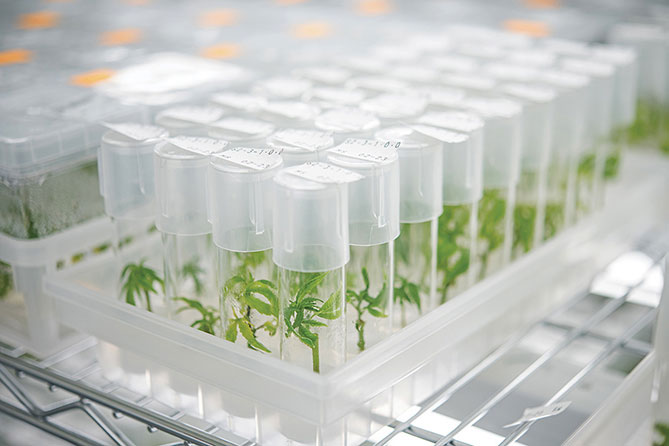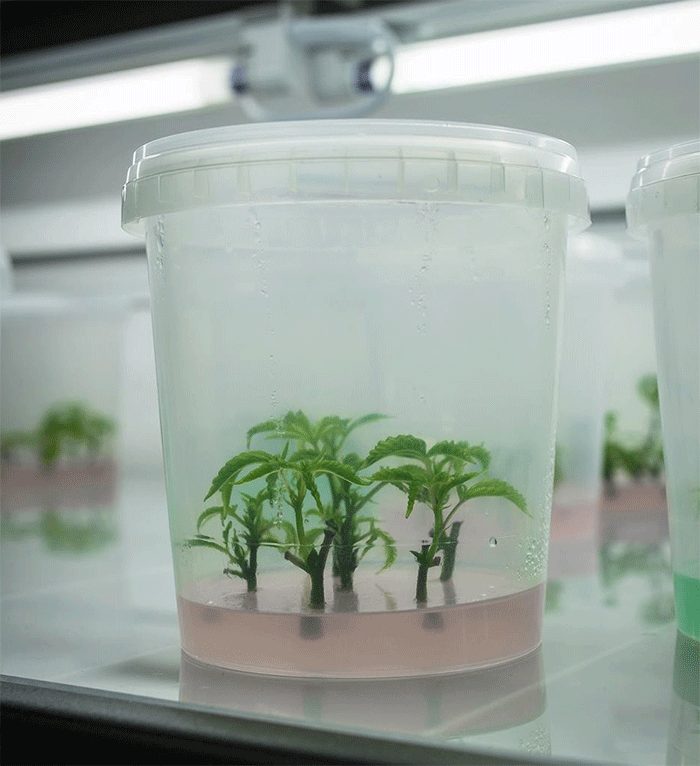Micropropagation in cannabis cultivation: A step closer to the future

Through technical progress and innovation, it is now possible to use a fascinating method of cloning alongside conventional cultivation methods - micropropagation, the in vitro (laboratory) cultivation technique. But what's behind this promising way of growing marijuana? Here you will learn not only the meaning and procedure of this technique, but also the questions about advantages and what exactly has to be considered or what requirements have to be met are not left unanswered.
What is micropropagation and why is it used?
With the legalization of marijuana expanding internationally, continuous progress is being made in the cultivation and processing of cannabis. Due to the countless valuable aspects of this plant, growers are trying to develop ever newer and more efficient ways of cultivation in order to generate a product of the very highest quality and the greatest possible yield. And it is at this point that tissue culture propagation plays a not insignificant role - known in the trade as micropropagation.

Micropropagation is used in the established scientific complex of tissue culture, which focuses on the cloning of plant cells.
In simple terms, micropropagation means the removal of very small units of plant material. This so-called tissue explant is fed into a small container that contains a special substance (more on this later) at the bottom of the vessel. Unlike other types of cultivation, where cuttings are separated from the plant and embedded in the soil for rooting, micropropagation enables the propagation or cloning of cannabis plants in a nutrient-rich medium without having to provide larger spatial capacities for this purpose. After only a short time, these plant parts grow and multiply exponentially, can be cut and grown separately, and cloned many times over.
The need behind this method, which wants to be satisfied, is clear for growers and the industry - to breed uniform genotypes with the lowest possible input.
If you want to specialize in tissue culture or micropropagation and apply it successfully, there are of course some framework conditions that must be strictly observed.
Tissue culture propagation requires an extremely sterile environment, therefore this method of propagation is not suitable for the garden shed or the home tool shed. In addition, a comprehensive and constant temperature, humidity and light control is indispensable. Of course, you should also have the basic knowledge of the methodology.
The magic potion of micropropagation
As with all living things, growth and survival is only possible with the supply of nutrients. As already mentioned, the tissue explant is placed in a special substance. Here, a hormonal balance is crucial. Above all, the addition of the plant hormones auxin and cytokinin are basic requirements for successful cloning of the mini cuttings.
Auxins are produced in the upper part of the plant and promote the development of root mass. At the same time, the formation of axillary buds is prevented. Exactly the opposite is the case with cytokinins, which are produced in the root area, promote the formation of axillary buds and counteract root development.
According to this, a high cytokinin concentration with low or no auxin content supports the healthy development of the axis and adventitious buds, i.e. the reproduction of the plants. Here, cell expansion is stimulated via the signal transduction pathways. And on top of that, very quickly.
There are other applicable nutrient media, also called media. Among others, the Murashige-Skoog medium. Originally, this was intended to discover a growth hormone in tobacco juice, but this was not crowned with success. Instead, it was found that higher concentrations of certain minerals were present in plant tissue in both pressed and ashed tobacco than had been assumed. Based on this finding, experiments were conducted which proved that the variation of these nutrients, especially nitrogen, favored increased growth.

Advantages over advantages
From a logistical point of view, growing marijuana plants conventionally is a major spatial challenge. Basically, growers not only want their plants to have the same physical characteristics, they also want the size of the growing cuttings to be or become as identical as possible. Additionally, an optimal state is desired in which all plants grown require exactly the same amount of nutrients and light - a difficult goal to achieve.
To get closer to this point, experienced growers use so-called mother plants to take clones, as they have the same genetic origin. However, this already reveals one of the greatest weaknesses of conventional cultivation, or rather one of the greatest strengths of micropropagation - only a limited number of clones can be taken from the mother plant, while the isolation of the tiny plant material knows no limits in the creation of clones. Accordingly, plant propagation by tissue culture is possible at such a high rate that thousands of new plants can be bred in a very short time.
Another important point, and of great benefit to physicians as well as industry, is the elimination of diseases such as bacteria, viruses or, for example, fungal infections. In the original cultivation of cuttings, a high susceptibility to mold and other pathogens becomes apparent during growth. This circumstance leads to the loss of entire plant cultures and reduces the yield by an incalculable percentage.
Micropropagation, and the uniform genotypes obtained from it, greatly reduces this risk, as the sterile conditions and spatial limitation allow the tissue to be separated more efficiently from pests and pathogens. In addition, tissue culture now also allows breeding clones or even important varieties of cannabis plants to be archived, used for research processes or even scientific models.
But the green idea is also served. In times of energy transition, micropropagation shines with sustainable and economical use of working materials. Since thousands of samples only take up a small amount of space, there is no need for a considerable amount of space and maintenance, which would naturally eat up energy as well as resources.
An overview of the micropagation process
As already described, a clean and sterile environment is essential for micropropagation. Equally important is the constant control of temperature, humidity and light intensity.
Step 1: The mother plant
Step one starts with the mother plant. The clones of this mother will be exact genetic copies of the mother plant, therefore it is important that the mother plant is healthy and has special and desired characteristics. A shoot, leaf segment or node is taken from the mother plant with a sterile scalpel. A young branch promises the greatest chance of success.
Step 2: Preparation of the explant
Step two involves cleaning and disinfecting the section or, in terms of tissue culture, the "explant". Excess or larger leaves are removed from the specimen. The explant is rinsed and cleaned of any contaminants with ethanol, bleach, and distilled water. It is then placed in a test tube containing a special nutrient-rich medium and sealed.
Step 3: Multiplication period
With proper care, an explant will propagate indefinitely.
Step 4: Rooting in vitro begins
At this stage, the plant material develops. Small, young shoots are formed.
Step 5: Transplantation and acclimatization phase
In this phase, the new clones are strengthened and accustomed to the changed growing conditions, so that they continue to develop with success.
A look into the future
Through research into innovation, widespread legalization, and development of new and increasingly effective cannabis technologies, it will eventually be possible for even the neighbor in his garden shed to propagate plants through micropropagation.
Not only the pursuit of the highest possible quality, but also the quantitative aspect will play more and more a role in the cultivation of marijuana. Imagine having the possibility to clone in a very short time a large number of plants that share the genetic conditions with each other and also the resistance to diseases and pathogens. A promising and innovative method that will revolutionize medicine, agriculture, industry and private households. Micropropagation is not only an excellent and effective method of propagation, it is rather a glimpse into the future with a multitude of possibilities.






